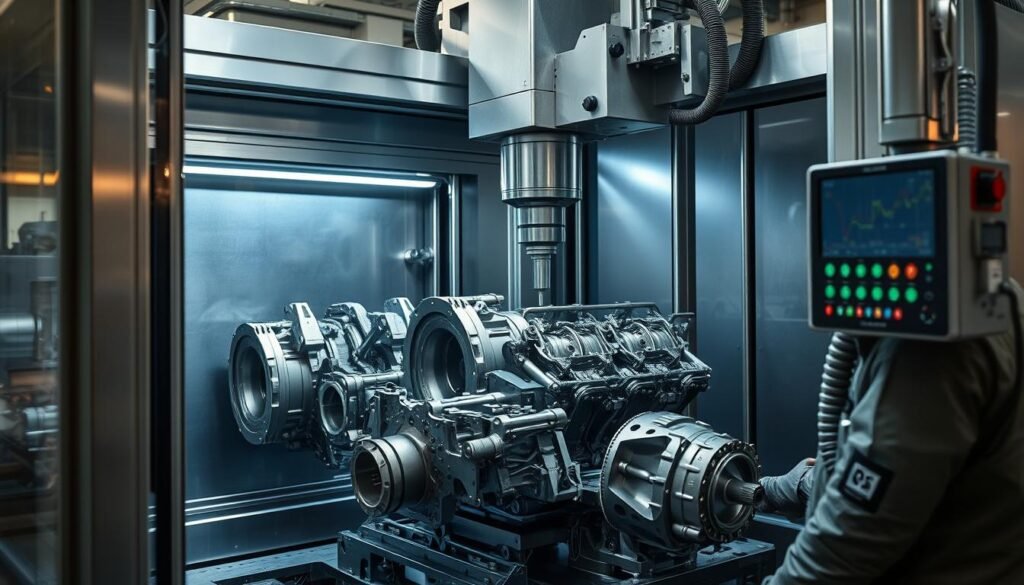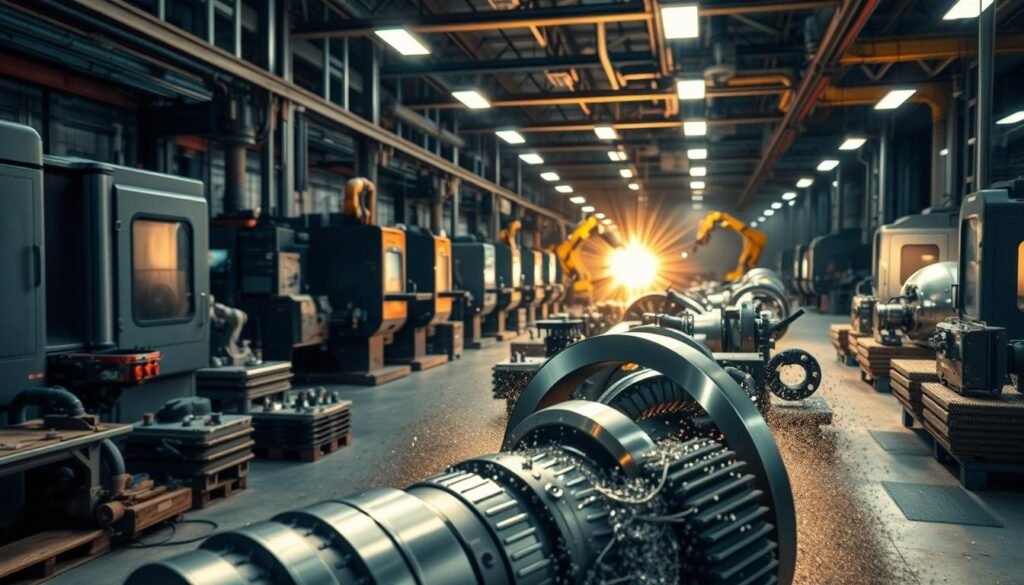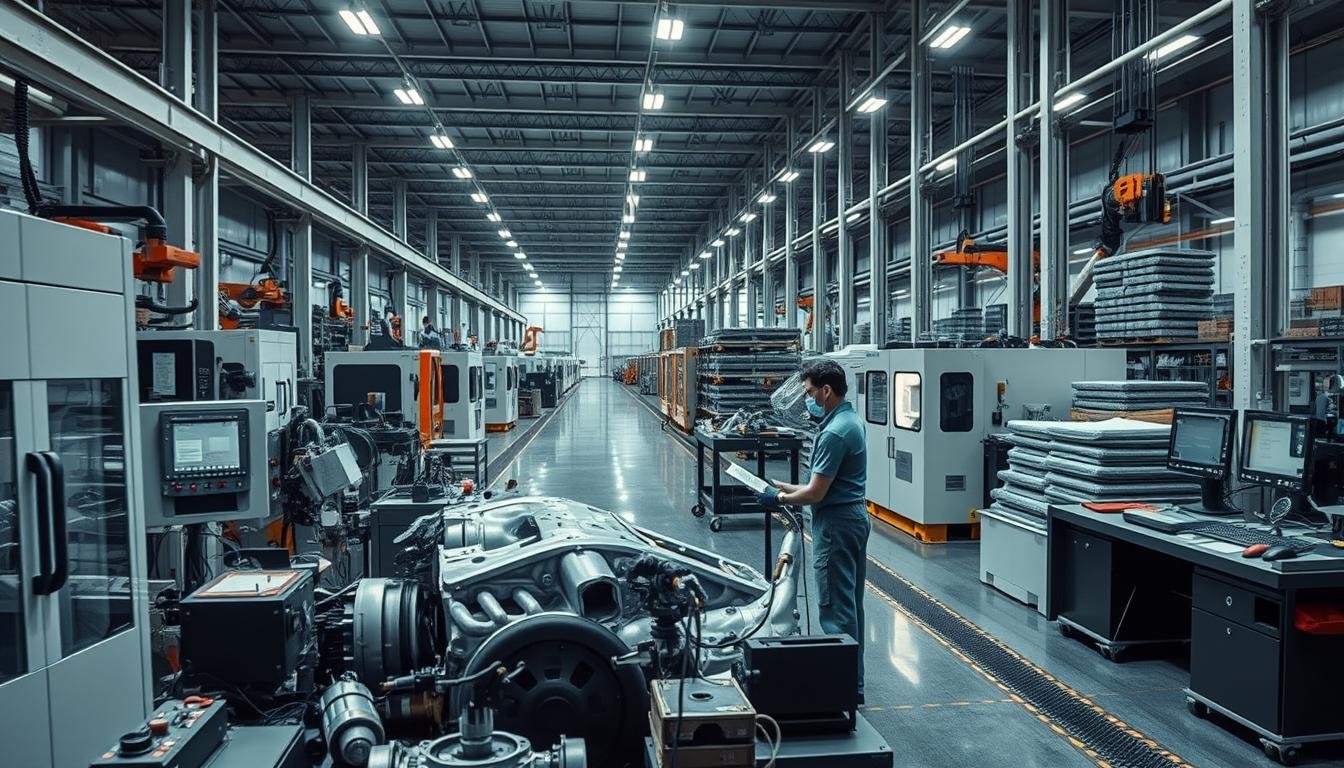CNC machining has changed the game in car making. It brings unmatched precision and speed to the process. This tech helps make complex car parts with great accuracy. It makes cars better, safer, and more customizable.
CNC machines work all day, every day. They cut down on idle time, keeping production smooth. They make parts faster and in bigger numbers, meeting car market needs. CNC ensures every part is made to exact standards, making quality parts consistently.
CNC lets makers create parts in many shapes and sizes. New tools and materials are used, making car parts even better. It can make parts as precise as ±0.001 inches, crucial for engines and suspension.
Key Takeaways
- CNC machining operates 24/7, reducing downtime in automotive manufacturing.
- Automatic CNC processes accelerate production, meeting market demands.
- Precision engineering ensures compliance with automotive industry standards.
- Diverse shapes and sizes of components are achievable with CNC machining.
- Advancements in tooling enable the use of advanced materials for better performance.
- CNC machining produces components with tolerances as tight as ±0.001 inches.
- Consistent quality is ensured across all produced parts.
Introduction to CNC Machining in Automotive Manufacturing
CNC machining has changed the game in car making. It brings unmatched precision and speed. Now, making complex car parts is fast and reliable.
Evolution of Manufacturing
Car making has changed a lot, thanks to CNC machining. It started in the 1940s to make things faster and more accurate. This was key during World War II.
In the 1960s, it moved from manual work to basic computer control. Then, in the 1980s, CAD and CAM came along. This made making parts easier and faster.
The 2000s brought more automation and robots. This made making parts even better, with less mistakes. Now, making many parts at once is easier.
Overview of CNC Technology
CNC uses computers to run machines like mills and drills. It turns designs into real parts, making them precise and the same every time. This is key for cars.
It’s great for making a few to a thousand parts. This fits the car industry’s needs for both lots and special parts. Companies like Mekalite show how important CNC is. For more on CNC, check out Mekalite’s CNC services.

CNC is getting better, like with 5-axis machining. This makes making parts even more complex. It also makes making parts cheaper and more sustainable. Now, 60% of car makers say CNC is key for staying ahead.
Benefits of CNC Machining for the Automotive Industry
CNC machining is changing the game in car making. It makes things faster and more precise. This means better quality and more cars made quickly.
Speed and Efficiency
CNC machines work fast, helping cars get made quicker. They cut down on mistakes and make making cars smoother. This helps companies keep up with the fast pace of the car world.

Precision and Accuracy
CNC machines are super precise. They make car parts like engines and transmissions just right. This is key for cars to run well and safely.
Consistency and Repeatability
Car makers need parts that are the same every time. CNC machines make sure this happens. They help keep quality high, even when making lots of parts.
| Automotive Component | Role of CNC Machining |
|---|---|
| Engine Components | CNC machining enhances fuel combustion and airflow efficiency by machining parts to exact tolerances. |
| Transmission Housings | Machined for high tolerance and durability, contributing to drivetrain strength. |
| Brake Calipers and Rotors | Produced with high-precision machining for improved braking efficiency. |
| Suspension Parts | Precise machining ensures optimal performance of critical suspension components. |
Using CNC machines for cars is a big win. It meets the car world’s high standards and opens the door for more innovation.
CNC Machining Techniques and Processes in Auto Manufacturing
Precision and efficiency are key in today’s auto making. Advanced CNC methods help us make high-quality car parts. We use different techniques like milling, turning, and drilling for this.
Milling
CNC milling is a big deal in car making. It removes material from a workpiece. It’s used for engine blocks and chassis parts.
This method is way faster than old ways. It makes parts with accuracy of 0.01 mm. This is important for keeping auto parts good and strong.
Turning
CNC turning makes cylindrical parts. It rotates material while shaping it. Axles and drive shafts are made this way.
This method is very precise, with tolerances of ±0.005 mm. It makes work faster and cheaper, boosting plant productivity by 15%.
Drilling
Drilling makes precise holes in car parts. It’s used for everything from simple panels to complex engine parts. CNC drilling makes sure holes are just right.
This is key for parts that need to be just so. It also cuts down on waste, helping the environment.

These methods are at the heart of modern car making. They help the industry grow a lot. Here’s a quick summary:
| Techniques | Applications | Benefits |
|---|---|---|
| Milling | Engine blocks, Chassis parts | High precision, Fast production speeds |
| Turning | Axles, Drive shafts | ±0.005 mm tolerance, Increased efficiency |
| Drilling | Panels, Engine components | Precise holes, Reduced material waste |
Key Automotive Components Produced with CNC Machining
CNC machining is key in car making. It’s all about precision, speed, and flexibility. This tech is vital for making important car parts. It boosts performance, safety, and reliability.
Engine Components
CNC makes engine parts like blocks, pistons, and camshafts. These need to be very accurate for the engine to work well. CNC ensures these parts meet strict standards.

It can also make parts from materials like aluminum and titanium. This shows CNC’s flexibility and power in car making.
Transmission Parts
Gears and shafts, key to the transmission, need CNC’s precision. They must be exact for smooth shifting and consistent performance. CNC makes sure these parts are just right.
The gearbox, with its many parts, also benefits from CNC’s accuracy. This ensures power is transmitted smoothly and efficiently.
Suspension and Steering Elements
Tie rods and steering racks are crucial for safety and control. CNC machining makes these parts strong and reliable. They’re vital for safe driving on different surfaces.
CNC machining helps keep production consistent and high quality. Here’s a list of key parts made with CNC:
| Component | Material | Critical Requirements |
|---|---|---|
| Engine Block | Aluminum Alloy | High Precision, Durability |
| Gear Shaft | Steel Alloy | Exact Tolerances, Smooth Operation |
| Steering Rack | Cast Iron | Operational Stress Resistance |
Materials Used in CNC Machining for Automotive Parts
Choosing the right materials is key for car parts to work well and last long. In car manufacturing, different materials are picked for their special qualities. Let’s look at the main materials used for car parts in CNC machining.
Metals
Aluminum and steel are top choices for car parts because they are strong and reliable. Aluminum alloys like 356-T6 and A356-T6 are great for engine parts like heads and blocks. They are light but strong.
Steel alloys like 4340 and 5140 are used for parts that need to handle a lot of stress. Cast iron, like G3000 and G3500, is used for engine blocks and suspension parts. It’s tough and can handle wear well.
Plastics
Plastics play a big role in car parts, mainly for parts that don’t carry a lot of weight. PVC and Nylon are popular because they are flexible and strong. PVC is often used in car interiors and for cable insulation.
Nylon is good for parts under the hood, like bushings and bearings, because it can handle high temperatures. Delrin and PEEK are also important plastics. Delrin is used for gears and safety parts because it’s low friction. PEEK is used in engine seals for its strength.
Composites
Advanced composites are getting more attention in car manufacturing because they are light but strong. They help cars run better and more efficiently. Carbon fiber composites are used for car chassis and body panels to make them lighter.
Other composites, like UHMV and PTFE, are used for parts that need to last a long time and have low friction. This includes guide rails and fuel hoses.
CNC Machining’s Role in Customization and Prototyping
In the world of car making, CNC machining is key for custom parts and quick prototypes. It lets makers meet and beat today’s car design needs. Making parts like engine pistons and gears with very tight tolerances is crucial.
Using machines with 3 to 5 axes helps make complex shapes with great accuracy. This is vital for making special parts that fit certain cars or meet customer wishes. High-quality prototypes are important for testing safety and performance.
CNC machining does more than just make parts; it helps bring new ideas to life. Quick prototyping means faster design changes, keeping makers ahead. This quickness is a big plus in the fast-changing car world.
Advanced software makes making parts more efficient. It helps with detailed designs and the best ways to make them. Finishing touches like powder coating make parts last longer and look better.
Automation and monitoring systems make making parts better and faster. This cuts down on waste and saves time and money. It also helps avoid mistakes.
As car designs get more complex, the need for CNC machining will grow. This will lead to better custom parts, prototypes, and making cars. CNC machining is more than just making parts; it shows our dedication to quality, new ideas, and meeting customer needs.
The Future Trends of CNC Machining in Automotive Manufacturing
The CNC machining world is changing fast. New materials, artificial intelligence, and help for self-driving cars are leading the way. These changes will keep making the car-making process better.
Advanced Materials
Lightweight alloys and composites are the future in car parts. They make cars go faster and use less fuel. CNC machines can shape these materials just right for better car performance.
Companies are getting new tech to work with these materials. This means cars will last longer and work better.
Artificial Intelligence
AI is making CNC machines smarter and more efficient. It helps predict when parts need fixing and cuts down on waiting time. This is key for car makers who need to work fast.
AI can make things 50% more efficient. It’s a big deal for CNC machining in cars.
Impact on Self-Driving Cars
Self-driving cars need special parts that are made with precision. CNC milling is key for making these parts. It ensures they are safe and reliable.
As cars get more automated, CNC machining’s role grows. It’s crucial for making the parts needed for self-driving cars.
Quality Control in CNC Machining for Automotive Parts
Keeping quality high in CNC manufacturing for auto parts is key. We use statistical process control (SPC) to watch and manage our work. This helps us catch problems early and avoid mistakes.
- Keeping machines in good shape is crucial. We clean, lubricate, and check them often. This keeps them running smoothly.
- Quality control software is very helpful. It lets us check things in real time and gives us reports to get better.
- Training our team is also important. When they know what to do, they make fewer mistakes.
We use special tools to check if parts are the right size. Machines like Coordinate Measuring Machines (CMM) help us get it just right. CNC machines can be very precise, within ±0.001 inches.
How parts look is also important. We aim for a surface roughness of 125 microinches (μin) or better. This makes parts work better.
Geometric dimensioning and tolerancing are also key. We need tolerances as tight as ±0.005 inches for important parts. We use Statistical Process Control (SPC) to keep quality steady. Keeping tools sharp and the environment right helps too.
We follow quality standards like ISO 9001 and AS9100. These show we’re serious about quality. We also do First Article Inspection (FAI) and Non-Destructive Testing (NDT) to check our work.
Conclusion
CNC machining has changed the car industry a lot. It has made making cars more precise, efficient, and reliable. Now, parts can be made with an accuracy of 4 μm.
This technology has many benefits. It makes making parts faster and with less mistakes. It also makes sure parts are the same quality every time.
CNC machining can handle complex shapes better than old methods. This makes it very important for making cars.
Looking to the future, CNC machining will get even better. It will use new materials and artificial intelligence. This will help make self-driving cars and parts that can fix themselves.
As we keep improving, CNC machining will be key in making better cars. It will make cars safer and faster.
FAQ
How has CNC machining revolutionized automotive manufacturing?
CNC machining has changed car making by making it more precise and efficient. It has replaced old ways of putting parts together. Now, cars are safer, better, and more custom.
What is CNC technology?
CNC (Computer Numerical Control) technology uses computers to control tools. It makes things like milling, turning, and drilling very precise. This is key for making car parts.
What are the main benefits of CNC machining for the automotive industry?
CNC machining brings many benefits to car making. It makes things faster and more precise. This means cars are safer and better.
What are the key CNC machining techniques used in automotive manufacturing?
The main techniques are:
– Milling: Makes parts like engine blocks.
– Turning: Makes round parts like axles.
– Drilling: Creates precise holes.
Which automotive components are commonly produced using CNC machining?
CNC makes many car parts. This includes engine blocks, gears, and parts for steering and suspension.
What materials are typically used in CNC machining for automotive parts?
Common materials are metals, plastics, and composites. Metals are strong, plastics are light, and composites are both strong and light.
How does CNC machining support customization and prototyping in the automotive industry?
CNC machining helps make new designs fast. It lets makers try out new ideas quickly. This makes making cars faster and more flexible.
What are the future trends of CNC machining in automotive manufacturing?
Future trends include using new materials and AI. This will make cars even better and more efficient. It will also help make self-driving cars.
How does quality control in CNC machining ensure high standards for automotive parts?
Quality control checks parts closely. It makes sure each part is made right. This keeps cars safe and working well.


